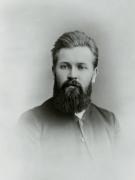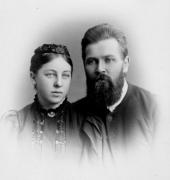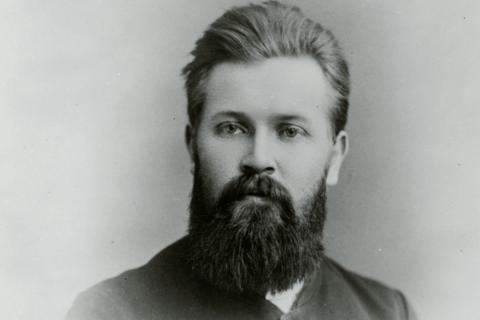Carl was born on 23 December 1871 at Fredersdorf, Uckermark, Germany. He was one of seven children and immersed from childhood in the Lutheran faith. His early education was at his father's Free Lutheran Church school. In 1888, he entered the seminary at Neuendettelsau and graduated in 1891. 1
He was sent to the Immanuel Synod in South Australia, a community of Lutheran Germans where he worked for the missionary, J. G. Reuther of the Bethesda Mission at Killalpaninna among the Dieri Aborigines near Cooper's Creek, South Australia. He had a proficiency for languages and within six months he was able to speak Diyari and while there he helped Reuther to translate the New Testament into the Diyari language. Unlike many other missionaries working in Australia, the German missionaries considered it essential to know a people’s language to be able to convey and persuade them of the ‘truth’ of Christianity, if conversion was to be by free will and choice.
Carl’s life at Hermannsburg
After the Immanuel Synod bought the dilapidated Finke River Mission at Hermannsburg in 1894, they appointed Strehlow to head the mission. By all accounts Carl embraced this opportunity with passion. He was only 22 at the time and had never before journeyed into Central Australia. One can only imagine how difficult the journey to Hermannsburg was for him and his feelings as he looked at the dilapidated settlement. We do know that he wasn’t impressed with what he saw as he wrote:
I was disappointed … It was very hurtful to see the jewels of a mission station, the little church and school, fallen into disrepair … There was not one Christian to welcome us like at Bethesda. Only a few naked heathens looked at us in amusement when we arrived.2
Strehlow left Hermannsburg only a few times during his twenty-eight years of service.
- He went to South Australia where he married his German fiancée Frieda Johanna Henrietta Keysser at Point Pass on 25 September 1895.
- In 1903-04 Strehlow, with his wife and their four children, spent leave in Adelaide.
- The family visited Germany in 1910-12.
It was not all smooth sailing for the Strehlow’s at the mission despite Carl’s dedication and passion for the work. The Mission was financially under resourced and at least in the early years Carl relied on some financial assistance from his family. Relationships with other European settlers in the area were often strained with Carl calling out the ill treatment that Aboriginal people suffered at the hands of some settler. And although Strehlow had been naturalized shortly after arriving in Australia, he was investigated by the Federal government during World War I for allegedly 'lecturing to aborigines regarding the present crisis on the European Continent'. These accusations were believed to have been fabricated by some of his enemies amongst the local settlers. He was exonerated.
Family Life
There is little accessible information about Carl Strehlow and his family life. He does not appear to have kept a diary that shared this information. However, he did correspond with his young fiancée Friedericke Johanna Henriette Keysser while he was in Australia and she still in Germany. In those letters he describes the mission and its environment in glowing terms. He married Frieda at Point Pass, South Australia on 25 September 1895. Together they had 6 children, (born between 1897 and 1908) five boys and one girl. All but one of whom were sent to Germany for their education. The youngest Theodor Georg Heinrich (Ted) Strehlow (1908-1978) stayed with them at Hermannsburg until Carl’s death.
Some colleagues found Carl Strehlow strong-willed, with a high opinion of his own ability; his rigid self-discipline made him a stern pedagogue and a strict parent. He was a dedicated missionary who placed his obligations to God above all else. A handsome, full-bearded man, stocky and robust, Strehlow strained his health by a relentless schedule which included pastoral, teaching, accounting and administrative duties, tending the sick and management of the mission farm. He devoted his leisure to linguistic and ethnological field-work and to preparing the results for publication in Germany.
The significance of Carl’s Work
Anna Kenny, suggests that one of the reasons Carl Strehlow’s work, relationships and attitude to Aboriginal people was so different to other anthropologists and researchers working in Australia at the time was that his, like his editor and mentor, von Leonhardi, views were shaped by German humanistic thinking.
Unlike the British anthropological tradition, which dominated Australian discourse, German anthropology was largely based on a humanistic agenda, and as a result it was anti-evolutionist, anti-racist and anti-colonial.3
Aside from the day to day missionary work Carl Strehlow left behind a valuable academic legacy with his linguistic works including:
- J.G. Reuther, C. Strehlow [translators]: Testamenta marra : Jesuni Christuni ngantjani jaura ninaia karitjimalkana wonti Dieri jaurani
- Strehlow: Die Grammatik der Aranda-Sprache, comparison of Aranda language with Dieri and Encounter Bay
- Strehlow: Woerterbuch der Aranda und Loritja Sprachen
- Strehlow, Kempe: Galtjindintjamea-Pepa Aranda Wolambarinjaka (book of worship)
- Strehlow: Pepa Aragulinja Aranda Katjirberaka (School primer, published 1928)
- Carl Strehlow: Die Aranda- und Loritja-Stämme in Zentral-Australien, Ed. Städtisches Völkerkunde-Museum Frankfurt am Main and Moritz Freiherr v. Leonhardi, Vol. 1-5, Frankfurt 1907-1920
- Ewangelia Lukaka. (Gospel of St. Luke in the Aranda or Arunta language.), 1925. London: B. & F.B.S.
- Ewangelia Taramatara(four gospels in Aranda), 1928 London: B. & F.B.S.
Strehlow’s relationship with the Arrarnta people
Carl Strehlow saw the indigenous people at Hermannsburg as individual human beings who could make free choices regarding their circumstances. He only accepted converts when he believed that they were firmly convinced of their step to conversion. Conversion and confirmation allowed indigenous people to participate at Hermannsburg as full members of the Lutheran community see for example Moses Tjalkabota’s story.
Unlike other missionaries at the time Carl did not refuse access to the mission or his help to those who did not wish to convert. Relatives of mission residents were allowed to visit freely and he did not interfere in traditional ceremonies as long as these took place away from the mission settlement. Many people camped by Finke River to the west of the compound and supported themselves by hunting and gathering edible plants. Some people were employed for years but never converted because as noted above Strehlow only accepted the conversion of people once he was convinced that they were sincere in their commitment and they understood what this meant.
That Carl was held in the highest regard by the people at the mission can be seen in part in the titles that people used to refer to him such as ingkata (teacher-ceremonial chief) and Pepa (or father). He was both the leader and protector of his flock of freely baptised Christians.
Strehlow’s Death
The sad story of Carl Strehlow’s death casts a long shadow over the mission at Hermannsburg. In 1922 when he was the desperately ill Strehlow left Hermannsburg on a horrendous trip headed south for medical treatment. He made it less than 150 miles (241 kilometres) before being able to travel no further. He died of dropsy (Edema) on 20 October 1922 at Horseshoe Bend Station and was buried there. His youngest son Thedor (Ted) and his wife Frieda were with him. Years later Ted Strehlow wrote a graphic and passionate account of his father’s final journey4 accompanied by his mother and Aboriginal companions, in extreme heat, along the dry riverbed of the Finke River, to the nearest railhead in search of medical assistance. In the book Ted Strehlow recounts his father’s pain, the struggle with his convictions and the feelings of abandonment in the face of the lack of assistance from the church in his time of need.
- Veit, W F. Strehlow, Carl Friedrich 1871–1922 Australian Dictionary of Biography Vol 12, 1990. http://adb.anu.edu.au/biography/strehlow-carl-friedrich-8698
- Kenny, A. 2013 The Aranda’s Pepa: An Introduction to Carl Strehlow’s Masterpiece Die Aranda- und Loritja-Stämme in Zentral-Australien 1907-1920 ANU Press p24
- Kenny, A. 2013 The Aranda’s Pepa: An Introduction to Carl Strehlow’s Masterpiece Die Aranda- und Loritja-Stämme in Zentral-Australien 1907-1920 ANU Press p4.
- Albrecht, P. Albrecht, 2002 From Mission to Church 1877-2002 Finke Fiver Mission. P283
- Strehlow, T.G.H., 2015 Journey to Horseshoe Bend Giramondo Publishing Co reprint original pub 1969
Media








